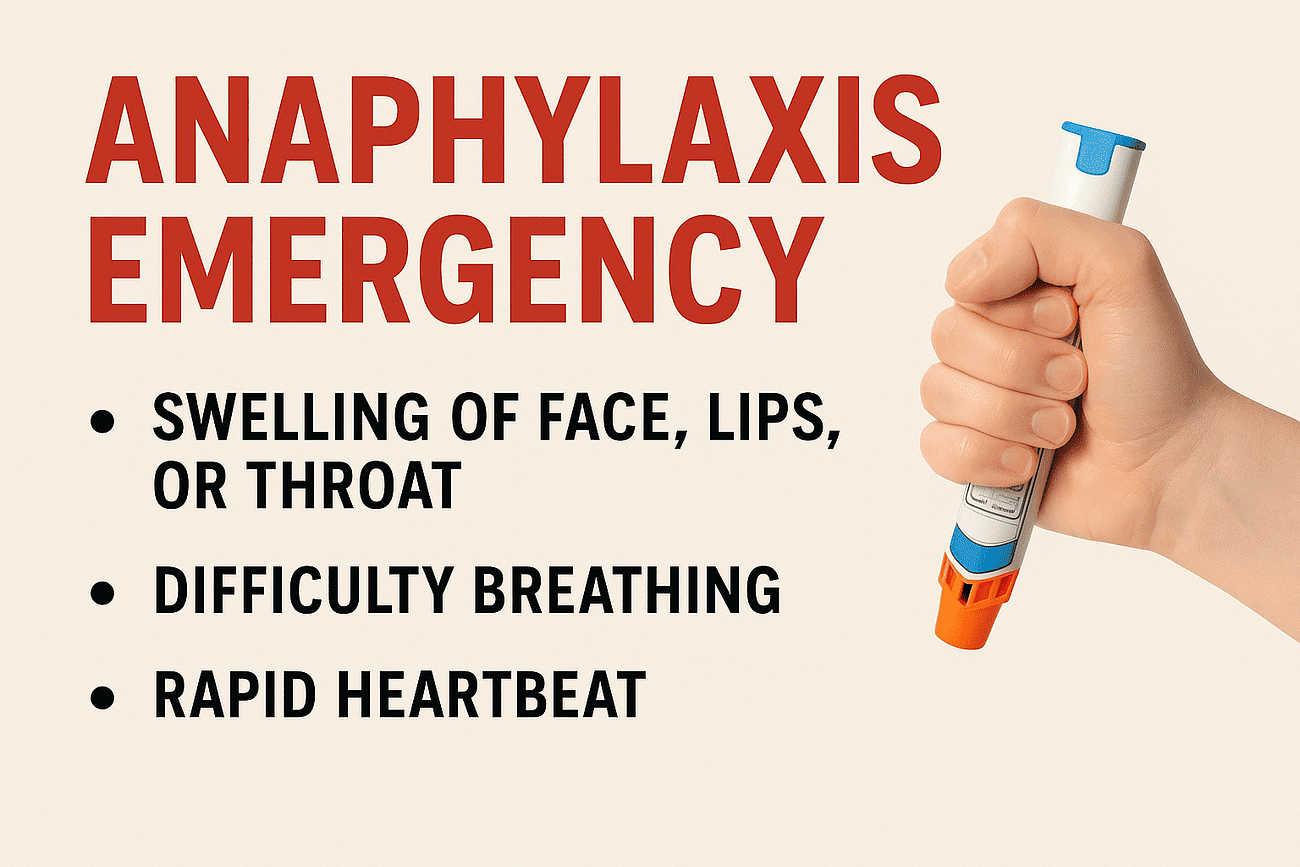What Is Anaphylaxis?
Anaphylaxis is a life-threatening allergic reaction that happens fast — often within minutes of exposure to an allergen. It doesn’t just affect one part of the body; it usually impacts multiple systems at once, including the skin, respiratory tract, heart, and digestive system.
If left untreated, anaphylaxis can be fatal. That’s why immediate medical attention is absolutely critical.
What Causes Anaphylaxis?
Anaphylaxis happens when the immune system mistakenly reacts to something harmless, like certain foods or medications, as if it were a real threat. This overreaction can trigger a powerful chain of allergic symptoms throughout the body.
In children, common triggers include foods like peanuts, tree nuts, milk, and shellfish.(Learn more about food allergies in children.) In adults, anaphylaxis can also be caused by insect stings, medications, or latex exposure. Even if a past allergic reaction was mild, future exposures can sometimes lead to a much more serious response.
Common triggers for anaphylaxis include:
-
Certain foods (like peanuts, tree nuts, shellfish, or milk)
-
Insect stings (especially bees or wasps)
-
Medications (such as penicillin or NSAIDs)
In rare cases, exercise or unknown causes (called idiopathic anaphylaxis) can trigger the reaction.
What Does Anaphylaxis Look Like?
Anaphylaxis can come on suddenly and affect multiple parts of the body at once. Early signs often include skin reactions like hives, redness, or swelling. Breathing problems, such as wheezing or throat tightness, can follow quickly. Some people may also feel dizzy, weak, or confused as their blood pressure drops. The symptoms can escalate in minutes, making it critical to recognize and treat anaphylaxis right away.
📌 Symptoms in Adults
In adults, anaphylaxis often starts with skin-related symptoms, such as:
-
Redness and itching
-
Swelling (especially of the face, lips, or throat)
-
Flushing and watery eyes
Then, respiratory symptoms usually follow quickly:
-
Nasal congestion, sneezing, and runny nose
-
Tightness in the throat
-
Wheezing and shortness of breath
If the reaction involves the digestive system, symptoms may include:
-
Nausea and vomiting
-
Abdominal pain, bloating, and diarrhea (more common in food-related allergies)
As the reaction escalates, cardiovascular symptoms may develop:
-
Dizziness and fainting (from a drop in blood pressure)
-
Rapid or irregular heartbeat
-
Palpitations
-
Chest pain
-
Blurred vision or even seizures in severe cases
🔍 Children, on the other hand, are more likely to show respiratory symptoms first, followed by skin symptoms — though the reason behind this pattern is still unclear.
How Quickly Does Anaphylaxis Start?
-
Most reactions begin within 5 to 30 minutes after exposure to the allergen.
-
For food allergies, symptoms may take longer — anywhere from 30 minutes to 2 hours (or even more).
Even if symptoms seem mild at first, like a small rash or itch, they can quickly escalate into a life-threatening emergency. The faster the symptoms appear, the more severe the reaction is likely to be.
What Happens in the Body During Anaphylaxis?
Anaphylaxis is your immune system’s overreaction to something it mistakenly sees as dangerous. Here’s what goes on inside:
-
Your immune cells release a flood of chemicals, including histamine.
-
These chemicals cause:
-
Smooth muscle spasms (leading to breathing and digestive trouble)
-
Dilated, leaky blood vessels (causing swelling, low blood pressure, and fluid loss)
-
Airway swelling, making it harder to breathe
-
Cramping and diarrhea
-
In severe cases:
-
Up to 35% of your blood plasma can leak into surrounding tissues within 10 minutes.
-
Blood pressure drops rapidly, leading to shock.
-
Heart arrhythmias may reduce blood flow, risking organ failure.
The antibody IgE (immunoglobulin E) is usually involved in triggering these responses, though not in every case.
Severe Signs of Anaphylaxis
Anaphylaxis often begins with mild symptoms, but it can quickly turn serious. Severe signs include swelling of the tongue or throat that makes breathing difficult, severe shortness of breath, chest pain, a rapid or weak pulse, and a sudden drop in blood pressure that can cause fainting. In some cases, people may feel a sense of panic or confusion or even lose consciousness.
Severe signs include swelling of the tongue or throat…”
Add small natural note:
(See a complete list of severe symptoms of anaphylaxis.)
Emergency Treatment for Anaphylaxis
Anaphylaxis is always a medical emergency.
You cannot treat it at home.
🚨 What To Do:
-
Call emergency services immediately.
-
Use an epinephrine auto-injector (like an EpiPen) if the person has one.
-
Do not wait to see if the reaction improves — go straight to the emergency room.
Managing allergies early can sometimes prevent severe reactions. Find out helpful allergy management tips.
Even after using an EpiPen, the person must be monitored in a hospital.
Why? Because a second, delayed reaction (called biphasic anaphylaxis) can occur hours later.
🩺 Ongoing Management
Your doctor may recommend:
-
Carrying an EpiPen if you’re at risk
-
Getting tested to identify your exact allergy triggers
-
Wearing a medical alert bracelet
Final Thoughts
Anaphylaxis is serious — but it’s also treatable with quick action and proper preparation.
If you or your child has ever had a severe allergic reaction, speak to your doctor about whether you should carry an epinephrine auto-injector and what steps to take in an emergency. When it comes to anaphylaxis, being prepared can save a life.

